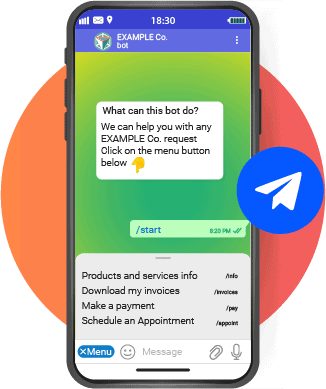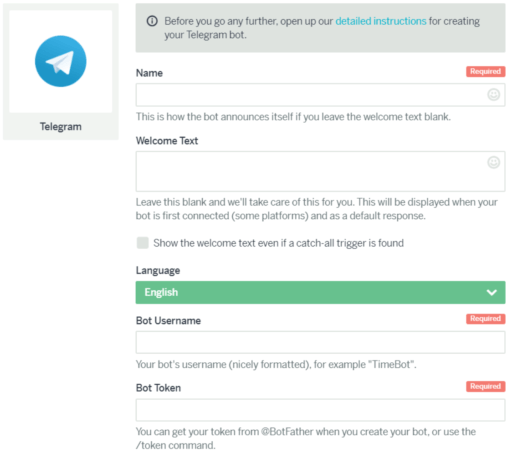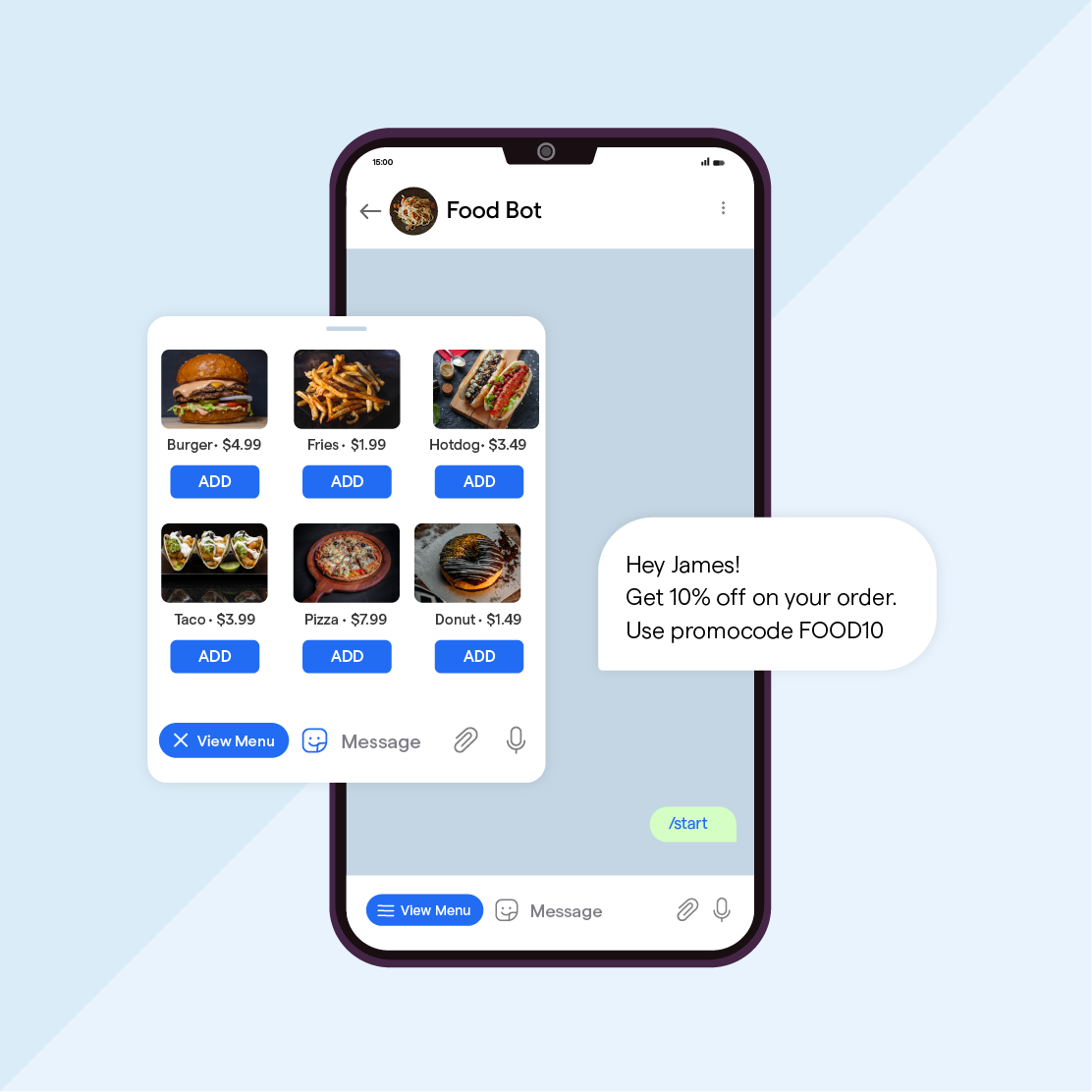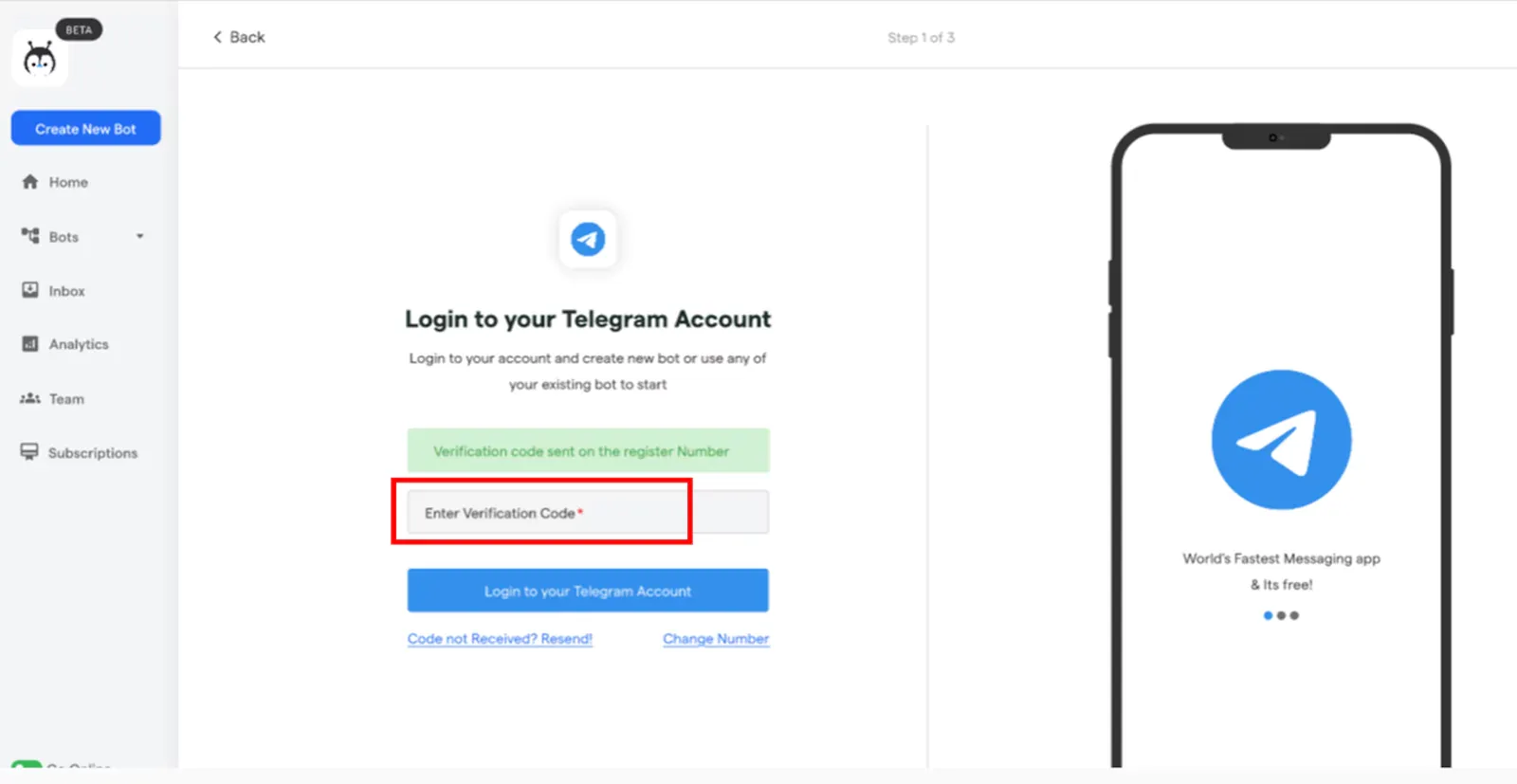Introduction
Telegram has grown tremendously over the years to become one of the top global messaging apps with over 700 million monthly active users as of 2022. In fact, Telegram chatbots now account for 30% of the popular app's monthly interactions.
The anatomy of a Telegram chatbot primarily consists of a Telegram API for configuration, a server for handling requests and a database for persisting data. But when created right, chatbots seamlessly blend into the Telegram user experience, allowing contextual conversations, rich media capabilities and more.
As businesses explore new channels to reach customers, introducing a brand-owned touchpoint via a Telegram bot makes immense sense. So let's dive right into a step-by-step guide on how to build a functional and effective telegram chatbot from scratch.
What is a Telegram chatbot?
A Telegram chatbot is a type of artificial intelligence-powered bot that interacts with users on the Telegram messaging platform. It is programmed to understand language, process requests and respond appropriately through text or multimedia messages.
Telegram chatbots function much like human representatives on messaging channels – understanding user queries, checking back on previous conversations for context. It also assists users by providing relevant information or performing actions.
For instance, a Telegram chatbot integrated with an e-commerce site may help users browse products, add items to cart, track order delivery status or even issue refunds for returned goods all over a conversational Telegram interface.
From enterprises to developers, anyone can build Telegram chatbots with capacities to handle customer support, process payments, generate leads or conduct market research by engaging audiences on this popular messaging platform.

Why build a chatbot on Telegram?
Telegram has firmly established itself as a front runner among global messaging platforms. Moreover, the infrastructure enables securely hosting these bots to manage millions of interactions with ease.
But why have over 30% of Telegram's monthly conversations shifted to its chatbots?
Evolving from basic FAQ tools, today's Telegram chatbots converse naturally using the latest NLP, understand context and even emulate human tendencies like humor or recommendations. This creates more meaningful, trust-building exchanges.
Rich interface options like buttons, images and emoji further personalize conversations as per brand objectives. It can be transactions, support, lead generation or community building.
From finding and booking events to controlling smart home devices, Telegram chatbots even demonstrate practical use-cases not possible within traditional apps. Seamless integration layers allow syncing data across other business software too.
With strong evidence suggesting the addition of a Telegram presence driving brand lift, the platform makes a compelling case for developers to build fully-functional, scalable chatbots leveraging its extensive capabilities.
4 Types of Telegram chatbots
Telegram chatbots have evolved considerably from simplistic information retrieval tools to advanced conversational agents delivering tremendous value. Let's dive deeper into the common Telegram chatbot types seen today:
1. Informational Bots
As the name suggests, information bots focus on keeping users updated across categories like news, weather, events or even latest deals. Content is usually sent proactively on pre-configured schedules rather than reactive conversations.
2. Interactive Bots
Interactive bots allow back-and-forth dialogues for diverse use cases. Like users can query weather reports, check order status, find movie showtimes or even debug issues right within message windows. Structured conversational flows billions of parameters guide accurate responses.
3. Transactional Bots
Transactional bots aim to facilitate activities involving monetary exchange like shopping, booking rides or making bill payments. After capturing relevant details, they connect via APIs to process payments, generate tickets seamlessly without redirecting users to websites or apps.
4. Analytical Bots
Bots in this category specialize in complex data analysis to uncover insights for users. Be it optimized routes, comparative pricing or even gauging sentiment on social media chatter. The outputs returned go far beyond textual responses.
Suggested Reading:How can a telegram chatbot improve your customer support?
Step-by-Step guide on building a Telegram Chatbot
In this section, we’ll see the step by step guide on building a Telegram chatbot.
Step 1
Planning Your Telegram Chatbot
Before building a Telegram chatbot, it is crucial to clearly define its purpose and goals. This includes identifying the specific tasks or services the chatbot will provide and determining what value it will bring to users. Understanding the desired outcomes will guide the development process and help create an effective chatbot.
Identifying your target audience and their needs
To build a successful chatbot, it is essential to identify the target audience and their needs. By understanding the characteristics, preferences, and pain points of your target audience, you can design a chatbot that addresses their specific requirements and provides a valuable user experience.
Setting up conversations and flows
Creating effective conversations and flows is key to a well-functioning chatbot. This involves defining the structure and sequence of interactions between the chatbot and the user. It is important to anticipate user queries and provide clear instructions and options to guide the conversation in a logical and intuitive manner.
Step 2
Creating a Telegram Bot Account
To create a Telegram chatbot, you must start by setting up a Telegram account and then proceed to create a bot account specifically for your chatbot.

Creating a Telegram account
Firstly, you need to download the Telegram app and sign up for an account. This involves providing your phone number and verifying it through an SMS code. Once the account is set up, you can access the Telegram platform on various devices, including smartphones, tablets, and computers.
Generating an API token
The API token is a unique identifier that allows your chatbot to authenticate and communicate with the Telegram servers. To generate an API token, you can use the token provided by the Bot Father after creating the bot account. This token needs to be securely stored and used in the development process to make API requests and receive responses.
Step 3
Building Your Telegram Chatbot
Before building your Telegram chatbot, you need to select a suitable chatbot development platform. There are various platforms available, both free and paid, that offer intuitive interfaces, pre-built features, and easy integration with Telegram's API. Examples of popular chatbot development platforms include BotPenguin.

Setting up the development environment
Once you have chosen a chatbot development platform, you need to set up the development environment. This typically involves installing the necessary software, libraries, and dependencies required by the chosen platform. You may also need to configure settings specific to Telegram integration and provide the API token generated earlier.
Step 4
Adding Functionality to Your Chatbot
To add functionality to your Telegram chatbot, it is important to understand the various methods provided by the Telegram Bot API. These methods allow you to send and receive messages, handle user interactions, and perform other actions. Some commonly used methods include sending text messages, sending images or files, and handling inline queries.
Handling user interactions and commands
To make your chatbot interactive and responsive, you need to handle user interactions and commands effectively. This involves capturing user input, understanding the intent behind their message, and executing the appropriate actions or providing the requested information. By implementing command handlers and utilizing user context, you can create conversational flows that are intuitive and user-friendly.
Step 5
Enhancing Your Chatbot's Intelligence
The core of an intelligent Telegram chatbot lies in its ability to comprehend requests and response aptly. While basic bots follow rules-based logic, integrating AI unlocks more human-like conversational experiences.
With Natural Language Processing (NLP), Telegram bots better decode ambiguous or colloquial phrases rather than just keywords to determine user intent. Accessing knowledge bases further enriches responses with helpful information.
Additionally, automatic speech recognition enables the bot to grasp voice notes for text processing. Sentiment analysis classifies positive, negative or neutral sentiment to gauge user reactions.
As data from conversations accumulates, machine learning trains bot models to handle complex queries, provide recommendations and even summarize long passages accurately. With continuous learning, the bot keeps improving.
Telegram also facilitates augmenting bots with external AI services like visual recognition, language translation etc via API integrations. By replicating human-like perception and decision making, AI-infused Telegram bots deliver more intuitive and enjoyable conversational experiences.
Step 6
Testing and Debugging Your Chatbot
Now, it's time to test and debug your Telegram chatbot.
Testing the chatbot on Telegram
Once you have implemented the desired functionality in your chatbot, it is crucial to thoroughly test its performance. Testing on the Telegram platform allows you to simulate real-user interactions and identify any potential issues or bugs. Ensure that the chatbot responds correctly to different scenarios, handles user inputs accurately, and provides a smooth user experience.
Debugging common issues and errors
During the testing phase, it is common to encounter issues or errors that require debugging. Some common issues include incorrect API configurations, faulty message handling logic, or unexpected behavior in response to certain inputs. Use debugging tools, log messages, and systematic error tracking to identify and resolve these issues promptly, ensuring that your chatbot functions as intended.
Gathering user feedback for improvement
To continuously improve your chatbot, gather user feedback and analyze user interactions. Encourage users to provide feedback on their experiences with the chatbot, identify areas of improvement, and address any user pain points. This feedback can help you refine your chatbot's functionalities, understand user preferences, and adapt to changing user needs over time.
Step 7
Deploying Your Chatbot on Telegram
Next step is deploying your chatbot on the Telegram platform.

Preparing the chatbot for deployment
Before deploying your chatbot on Telegram, ensure that it is properly configured and ready for production. Double-check the API configurations, ensure that all functionalities are working correctly, and optimize the performance of your chatbot. Prepare any necessary documentation or guidelines for deployment to streamline the process.
Deploying the chatbot using dedicated hosting or cloud services
To deploy your chatbot, you can choose between dedicated hosting or cloud services. Dedicated hosting involves setting up servers or infrastructure specifically for hosting your chatbot.
Handling maintenance and updates
After deployment, it is essential to handle maintenance and updates for your chatbot. This includes monitoring its performance, ensuring its availability, and addressing any issues that arise.
Regularly update your chatbot with new features, bug fixes, or performance enhancements to continually provide a high-quality user experience. Stay informed about Telegram updates or changes that may affect your chatbot and make the necessary adjustments accordingly.
Step 8
Promoting and Marketing Your Chatbot
Creating the Telegram chatbot won’t be enough. Promoting and marketing is also an important step.

Creating a landing page and promotional materials
To promote your chatbot and attract users, create a dedicated landing page and promotional materials. The landing page should highlight the key features and benefits of your chatbot and provide easy access to start using it.
Leveraging social media and other channels for promotion
Utilize social media platforms and other relevant channels to market your chatbot. Engage with potential users through posts, updates, or advertisements that highlight the unique capabilities and benefits of your chatbot. Consider collaborating with influencers or partnering with relevant communities or organizations to expand your chatbot's reach and attract a larger user base.
Analyzing and optimizing the chatbot's performance
Continuously analyze and optimize your chatbot's performance based on user metrics and feedback.
Conclusion
And that wraps up the main steps involved in building your own custom Telegram chatbot! You saw the key aspects - from finalizing use cases, setting up Telegram API access and hosting to designing conversational flows using dialog trees and integrating external components like databases.
While the guide has aimed to provide a broad overview, partnering with a reliable chatbot platform like BotPenguin can significantly accelerate your go-to-market. BotPenguin brings specially optimized Telegram bot templates crafted for outcomes like lead generation, community engagement and support ticketing. Its drag-and-drop bot builder, NLP engines and analytics dashboards make creating an enterprise-grade Telegram bot easy without intensive coding.
As a pioneering chatbot provider with 1000s of clients across industries, BotPenguin also delivers round-the-clock monitoring and maintenance services once your Telegram bot is live. This ensures your bot keeps delivering maximum uptime and ROI while you focus on your core business priorities.
So unlock the power of conversational interfaces on Telegram and prepare to augment customer experience strategies at scale by consulting BotPenguin's domain experts today!
Frequently Asked Questions (FAQs)
How do I start building a Telegram chatbot?
To start building a Telegram chatbot, you need to create a bot using the Telegram Bot API and obtain an API token. Then, develop your chatbot using a programming language of your choice.
What functionalities can I add to my Telegram chatbot?
You can add various functionalities to your Telegram chatbot, such as sending messages, handling user interactions, integrating third-party APIs, implementing natural language processing, and using machine learning to improve responses.
How do I test and debug my Telegram chatbot?
To test your Telegram chatbot, simulate real-user interactions and ensure it responds correctly. Use debugging tools, track errors, and address issues promptly to ensure smooth functionality.
How can I deploy my Telegram chatbot?
You can deploy your Telegram chatbot by configuring it properly, preparing necessary documentation, and choosing between dedicated hosting or cloud services like AWS or Heroku for deployment.
How can I promote and market my Telegram chatbot?
Create a dedicated landing page and promotional materials to showcase the key features. Leverage social media, collaborate with influencers, and analyze user metrics to optimize and promote your chatbot effectively.

